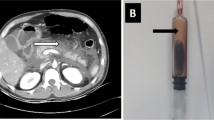Abstract
Thirty-three patients referred consecutively following an attack of pancreatitis at least six weeks earlier (acute pancreatitis in 10 patients and chronic pancreatitis in 23 patients) had an intravenous fat tolerance test to determine their capacity to catabolise circulating triglycerides. Hypertriglyceridaemia was present in 14 patients (42%), including 5 with acute pancreatitis and 9 with chronic pancreatitis. the highest serum triglyceride level was 6.2 mmol/l and none of the patients had chylomicronaemia at the time of examination. Four of the patients with hypertriglyceridaemia had impaired triglyceride clearance (29% of those with hypertriglyceridaemia, representing 12% of the patients as a whole). These four patients were indistinguishable from the others with hypertriglyceridaemia on clinical or routine biochemical grounds. Although triglyceride clearance in the other 10 patients with hypertriglyceridaemia was lower on average (P<0.04) than in the subgroup of patients with normal levels of serum triglycerides, the clearance values were within the normal range and did not correlate with the serum triglyceride levels.
We conclude that an intravenous lipid tolerance test is a useful means of identifying patients with a defect in triglyceride catabolism, who might be vulnerable to a further attack of pancreatitis due to massive hypertriglyceridaemia in certain circumstances. In the majority of patients found to have hypertriglyceridaemia after an attack, the serum lipid disturbance is unlikely to be the direct cause of the attack, but may be an epiphenomenon of some process that is linked to acute and chronic pancreatitis.
Similar content being viewed by others
References
Fischer, B. Über lipamie und Cholesteramie, sowie über Veranderungen des Pankreas und der Leber bei Diabetes mellitus, Virchows Arch., 1903; 172: 30–71.
Holt, L.E., Aylward, F.X. and Timbres, H.G. Idiopathic familial lipaemia, John Hopkins Hosp. Bull., 1939; 64: 279–314.
Klatskin, G. and Gordon, M. Relationship between relapsing pancreatitis and essential hyperlipaemia, Am. J. Med., 1952; 12: 3–23.
Fredrickson, D.S., Goldstein, J.L. and Brown, M.S. Familial hyperlipoproteinaemias. In: J.B. Stanbury, J.B. Wyngaarden and D.S. Frederickson (Eds.), The Metabolic Basis of Inherited Disease, 4th ed. McGraw-Hill, New York, 1978: 608–665.
Farmer, R.G., Winkelman, E.I., Brown, H.B. and Lewis, L.A. Hyperlipoproteinaemia and pancreatitis, Am. J. Med., 1973; 54: 161–165.
Cameron, J.L., Capuzzi, D.M., Zuidema, G.D. and Margolis, S. Acute pancreatitis with hyperlipaemia the incidence of lipid abnormalities in acute pancreatitis, Ann. Surg., 1973; 177: 483–489.
Brunzell, J.D. and Bierman, E.L. Chylomicronaemia syndrome. Interaction of genetic and acquired hypertriglyceridaemia, Med. Clin. N. Am., 1982; 66: 455–468.
Havel, R.J. Pathogenesis, differentiation and management of hypertriglyceridaemia, Adv. Intern. Med., 1969; 15: 117–154.
Glueck, C.J., Scheel, D., Fishback, J. and Steiner, P. Oestrogen-induced pancreatitis in patients with previously covert familial type V hyperlipoproreinaemia, Metabolism, 1972; 21: 657–665.
Chait, A., Mancini, M., February, A.W. and Lewis, B., Clinical and metabolic study of alcoholic hyperlipidaemia, Lancet 1972; 2: 62–64.
Cameron, J.L., Capuzzi, D.M., Zuidema, G.D. and Margolis, S., Acute pancreatitis with hyperlipaemia. Evidence for a persistent defect in lipid metabolism, Am. J. Med., 1974; 56: 482–487.
Rossner, S. Studies on an intravenous fat tolerance test. Methodological, experimental and clinical experiences with Intralipid, Acta. Med. Scand. Suppl., 1974; 564, 1–24.
Lewis, B. Laboratory practice, II: lipoproteins and function tests. In: The hyperlipidaemias: Clinical and Laboratory Practice, Blackwell, Oxford, 1976: 400–419.
Rossner, S. Further methodological studies on the intravenous fat tolerance with Intralipid emulsion, Scand. J. Clin. Lab. Invest., 1976; 36: 155–159.
Braganza, J.M. Does your patient have pancreatic disease? J. R. Coll. Phys. 1982; 16: 13–22.
Slack, J., Noble, N., Meade, T.W. and North, W.R.S. Lipid and lipoprotein concentrations in 1604 men and women in working populations in north-west London, Brit. Med. J. 1977; 2: 353–356.
Durrington, P.N. and Cairns, S.A. Acute pancreatitis: a complication of beta-blockade, Brit. Med. J., 1982; 284: 1016.
Fallat, R.W., Vestor, J.W. and Glueck, C.J. Suppression of amylase activity by hypertriglyceridaemia, J. Am. Med. Assoc., 1973; 225: 1331–1334.
Lesser, P.B. and Warshaw, A.L., Diagnosis of pancreatitis masked by hyperlipidaemia. Ann. Intern. Med., 1975; 82: 795–798.
Warshaw, A.L., Bellini, C.A. and Lesser, P.B. Inhibition of serum and urine amylase activity in pancreatitis with hyperlipaemia, Ann. Surg., 1975; 182: 72–75.
Guzman, S., Nervi, F., Llanos, O., Leon, P. and Valdivieso, V. Impaired lipid clearance in patients with previous acute pancratitis, Gut, 1985; 26: 888–891.
Wang, C., Strauss, L. and Adlersberg, D. Experimental pancreatitis and plasma lipids, Gastroenterology, 1958; 35: 465–472.
Stackhouse, K.L., Glass, D.D. and Zimmerman, B. Relationships of lipoprotein lipase and hyperlipaemia in pancreatitis, Surg. Forum, 1966; 17: 343–344.
Braganza, J.M. Pancreatic disease: a casualty of hepatic “detoxification”, Lancet 1983; ii: 1000–1003.
Martin, P.J., Martin, J.V. and Goldberg, D.M., γ-Glutamyl transpeptidase, triglycerides and enzyme induction, Br. Med. J., 1975; i: 17–18.
Durrington, P.N., Roberts, C.J.C., Jackson, L., Branch, R.A. and Hartog, M. Effect of phenobarbitone on plasma lipids in normal subjects. Clin. Sci. Mol. Med., 1976; 50: 349–353.
Author information
Authors and Affiliations
Rights and permissions
About this article
Cite this article
Durrington, P.N., Twentyman, O.P., Braganza, J.M. et al. Hypertriglyceridaemia and abnormalities of triglyceride catabolism persisting after pancreatitis. Int J Pancreatol 1, 195–203 (1986). https://doi.org/10.1007/BF02795245
Received:
Accepted:
Issue Date:
DOI: https://doi.org/10.1007/BF02795245




